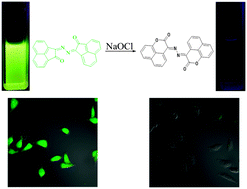A specific and rapid “on-off” acenaphthenequinone-based probe for HOCl detection and imaging in living cells†
Abstract
A fluorescent probe exhibiting specific and sensitive properties towards HOCl was successfully developed on the basis of the Baeyer–Villiger reaction. It worked well both in solution and on test papers, allowing the facile monitoring of hypochlorite. The probe was further used for imaging in living cells.


 Please wait while we load your content...
Please wait while we load your content...